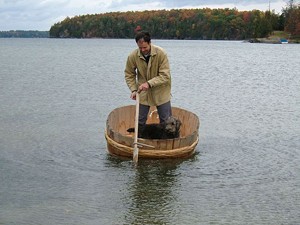Published June 4, 2008 at 12:41 p.m.
About six years ago, a strange little animated film reached our shores from Japan. Spirited Away, the work of Japanese history buff Hayao Miyazaki, contained a scene in which a girl escapes from her pursuers in a boat resembling a wooden barrel cut in half at its midsection — a taraibune.
This might have been the last glimpse people on either side of the Pacific had of the 130-year-old vessel, had it not been for the work of Vergennes boat maker Douglas Brooks. In fact, the 48-year-old has almost single-handedly saved the craft of Japanese wooden boat building from extinction. Now he’s writing a book that will share those techniques with the world.
Brooks acquired his habit of rescuing historical boats from obscurity during a college semester exchange at the Mystic Seaport Museum in his home state of Connecticut. As a break from his philosophy major, he helped rebuild a lobster skiff, and soon he was hooked: Brooks continued to research, restore and construct wooden boats over the ensuing quarter-century.
Among other projects, he rebuilt a National Historic Landmark — a 36-foot motor lifeboat — for California’s park service. He constructed from scratch a 25-foot replica of the first European cutter to sail Washington State’s Columbia River. On a visit to Vermont in 1995, he built a 19th-century sharpie yacht for the Lake Champlain Maritime Museum in Vergennes. In 1997, Brooks moved to Vergennes to work on the restoration of another National Historic Landmark, the side-wheel steamer Ticonderoga at the Shelburne Museum. Now, with Lake Champlain’s 400th anniversary in 2009 fast approaching, he is raising funds to build a replica of Samuel de Champlain’s boat for the Henry Sheldon Museum in Middlebury.
Such stateside projects can be recreated from historical documents. In Japan, however, knowledge of boat making is passed down from master to apprentice. There are no books. And when there are no more apprentices, as Brooks discovered while touring Japan, the craft disappears.
On 12 separate visits to the country over the last 18 years, Brooks apprenticed with some of the few master boat builders left in this ancient maritime culture. His book will explain how to build five types of traditional Japanese wooden boats — a document invaluable to future generations after his teachers, all over 70 when he first met them, pass away.
In the kitchen of his meticulously restored 1875 house, Brooks tells the story — almost without pausing for breath — of how he was drawn into Japan’s secretive apprentice boat-building culture. His college roommate was from Hiroshima. “Nobu begged me for 10 years to come to Japan,” Brooks says. When an early job at San Francisco’s maritime museum ended in 1990, Brooks let his friend know in a letter. Within a week, Nobu had sent him a plane ticket. Brooks visited his friend and stayed in youth hostels in Tokyo and Kyoto. He eventually tired of being “a slightly older Lonely Planet tourist” — he turned 30 on that trip.
Along the way, however, he had spotted an intriguing magazine photo of a woman paddling that bucket-shaped boat. Nobu translated the caption, which identified it as a taraibune, or tub boat, off the coast of Ogi, a tiny village on Sado Island in the Sea of Japan. Brooks whipped out his rail pass, found his way to the village, and asked the men at its only gas station, in halting Japanese, who had built the boat in the picture. “Without a word, they put me in the back of their pickup truck and dropped me at his place,” Brooks recalls.
Japan is a culture of regional specialties. So Brooks was not surprised to learn that the taraibune, invented in the 1880s for women to harvest shellfish and seaweed, is still used in only six Sado Island villages in the whole of Japan. But he was startled to hear that the builder he met that day, Koichi Fujii, was the last man alive who knew how to make one. Even more alarming, Fujii-san had never had an apprentice, and he was already in his early seventies.
Brooks wanted to learn how to make the tub boat, but it wasn’t a matter of simply asking. Traditionally, Japanese master boat builders only share their knowledge with carefully chosen apprentices, often hiding their most important techniques from them because their apprentices could become their competitors. Boat builders even send their own sons to be apprenticed elsewhere, Brooks explains, just to be hard on them.
Builders rarely write down their measurement ratios, and they burn their scrap models. The apprenticeship system is adequate for passing on memorized knowledge — until a massive cultural shift happens, such as Japan’s post-war rebuilding period, says Brooks, and all the children move to the cities. “Rural Japan is elderly,” he adds.
On Brooks’ third visit to Fujii’s workshop, he proposed becoming the master’s apprentice. Fujii-san accepted because the young American had proved himself to be majime — serious and diligent. What followed was a new turn in the trajectory of Brooks’ career. He built a tub boat under his teacher’s direction — just three years, it turned out, before the man died in an accident. Brooks also documented the process for the first time in articles published in Japan, America and England, as well as in a bilingual book published by a Japanese cultural foundation. So thoroughly did he learn the techniques that he was able to train a carpenter on Sado Island to continue the tradition — though in a Western, unsecretive style.
Brooks went on to scour 8000 miles of Japan’s coast for the last masters of the trade, on a $175,000 grant from the Freeman Foundation of Stowe, Vermont. (Doreen and Houghton Freeman lived in Japan for 25 years. Fittingly, there is now a fishing boat in Japan, built by Brooks and a team of helpers, named Doreen.) He found 42 of those experts – but they had never heard of one another, because “there’s no association of boat builders in Japan like there is here,” Brooks explains. These men, ages 67 to 93, had collectively taught five apprentices. “It’s like an upside-down pyramid; that’s where the craft is going,” he declares.
Brooks apprenticed with three of these aging masters to construct four more types of fast-disappearing vessels: the bekabune, a more traditionally shaped seaweed-gathering boat; the chokkibune, a speedy water taxi from the Edo era powered by a sculling oar; the tenmasen, a cargo boat propelled by pole through Tokyo’s Edo-era canals; and the shimaihagi, a decoratively carved fishing boat. He was each builder’s sole apprentice.
There were no short cuts. Brooks learned and documented traditional building techniques, such as using fire or ceiling-braced props to bend planks. With master builder Nobuji Udagawa, he constructed a bekabune inside a museum near Tokyo using only hand tools. Udagawa-san revealed that he had bought his first and last power tool in 1955 — a band saw.
Japanese technical construction is awe-inspiring, says Brooks. While Western boats consist of planks nailed to a latticework of ribs, Japanese craft have no framework; the planks are nailed to each other. So seamlessly is this done, he explains, that no caulking is needed — until a boat is old and falling apart. “Their techniques are kind of mind-blowing,” Brooks says. One builder he met “looked at me and said, ‘I hear you caulk your boats — when they’re brand new. You must be awful boat builders.’ I knew I couldn’t convince him,” he concludes with a laugh.
Brooks’ book on his four apprenticeships is being funded by a publishing grant, administered by the Shelburne Arts Center, from the United States-Japan Foundation of New York City. He had considered going the traditional route and submitting the book to specialty-boat book publishers, but soon learned from friends in the trade that such a plan was “a losing proposition, financially.” Instead, his $20,000 advance is coming out of a grant total of $65,000; the rest will fund the cost of publication. The book will include stories — of his teachers, their methods and their memories — as well as measurements and explanations that will make it possible for future generations to pick up the book and build the boats from scratch.
Brooks is keenly aware of the irony that a Japanese craft tradition will only survive because a Westerner blew its secrets. But how do the master builders feel about it? “These men are at the end of their lives, and they completely get it,” Brooks declares. “They’re so supportive because they know it’s all about to be lost.”
As a Westerner, Brooks could ask direct questions of the teachers, something that wouldn’t have been tolerated had he been Japanese. His origins offered another advantage: At ease with both physical labor and educated communication, he could bridge a still-broad gulf in Japanese culture between blue- and white-collar workers. “No one in Japan is [both] a museum curator and a boat builder. Curators are PhDs who have never touched a tool,” Brooks explains. Consequently, he found, museum curators and foundation directors “were surprised you could describe the craft in words.”
He sums up the history that led to the current state of Japanese wooden boat building: “In this country, the apprentice system disappeared a hundred years ago, and World War II wiped out traditional building. But in Japan it was the opposite. My last teacher, [Kazuyoshi] Fujiwara-san, would have liked to be a schoolteacher, but Tokyo had been flattened. So apprentice crafts got one more generation. By the 1960s, though, sons could ditch what Dad did for a living.”
Lately, Brooks adds, younger generations are starting to form “a sort of 21st-century, back-to-the-land hippie movement,” as they recognize what is being lost in Japan’s high-tech urban culture.
Though his workshop is in West Cornwall, Brooks stores one of the taraibune he made in the shed below his house. The 4-foot-long, 5-foot-wide, 1.5-foot-deep oval, made from Japanese cedar planks bound with braided bamboo, has a rope loop on one side for an oar, which is maneuvered in figure eights to propel the tub. It’s hard to imagine a fashion-conscious twentysomething Tokyo woman jumping into one of these contraptions to harvest sazae (a pricey shellfish) for a living. But if they ever do want to make the boat, they’ll have Brooks’ book.
Closer to home, Brooks is at work rescuing another piece of history: Samuel de Champlain’s shallop. While the loss of knowledge is not quite so imminent here, Brooks is worried. He’s heard talk of building a replica in Québec, but nothing more, he says, and Vermont’s proposed quadricentennial events strike him as short on detailed historical reconstruction: “It’s really funny to look back at the documents for the 300th and 350th celebrations. Everything — even costumes — was about trying to replicate what happened. Now, they think having an art fair is enough.”
While Champlain didn’t actually sail the shallop into Lake Champlain — he couldn’t get past the falls at Chamblis, Québec, so he joined some Indians in their boat, Brooks explains — the craft was “the first European vessel to enter our region.” Hopefully, someone with deep pockets will, like the Japanese master craftsmen, completely get it.
More By This Author
Speaking of...
-

Q&A: Catching Up With the Champlain Valley Quilt Guild
Apr 10, 2024 -

Video: The Champlain Valley Quilt Guild Prepares for Its Biennial Quilt Show
Apr 4, 2024 -

Q&A: Exploring the Haskell Free Library & Opera House With Hannah Miller
Mar 13, 2024 -

Video: Hannah Miller Visits the Haskell Free Library & Opera House in Derby Line, Vt., and Stanstead, Québec
Mar 7, 2024 -

Q&A: Meet a Family in Waterbury That Embraces Halloween Year-Round
Feb 14, 2024 - More »
Comments
Comments are closed.
From 2014-2020, Seven Days allowed readers to comment on all stories posted on our website. While we've appreciated the suggestions and insights, right now Seven Days is prioritizing our core mission — producing high-quality, responsible local journalism — over moderating online debates between readers.
To criticize, correct or praise our reporting, please send us a letter to the editor or send us a tip. We’ll check it out and report the results.
Online comments may return when we have better tech tools for managing them. Thanks for reading.














































